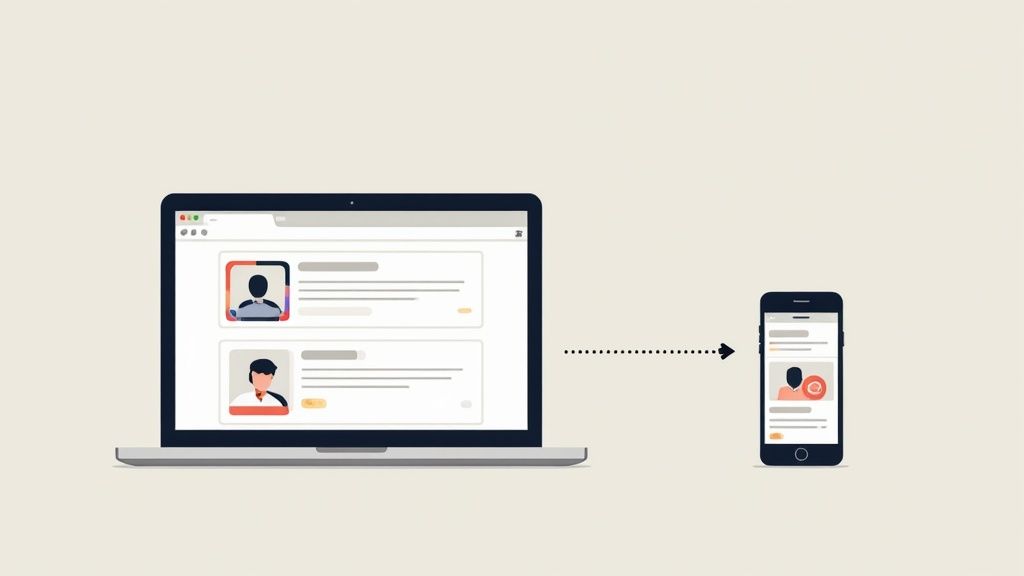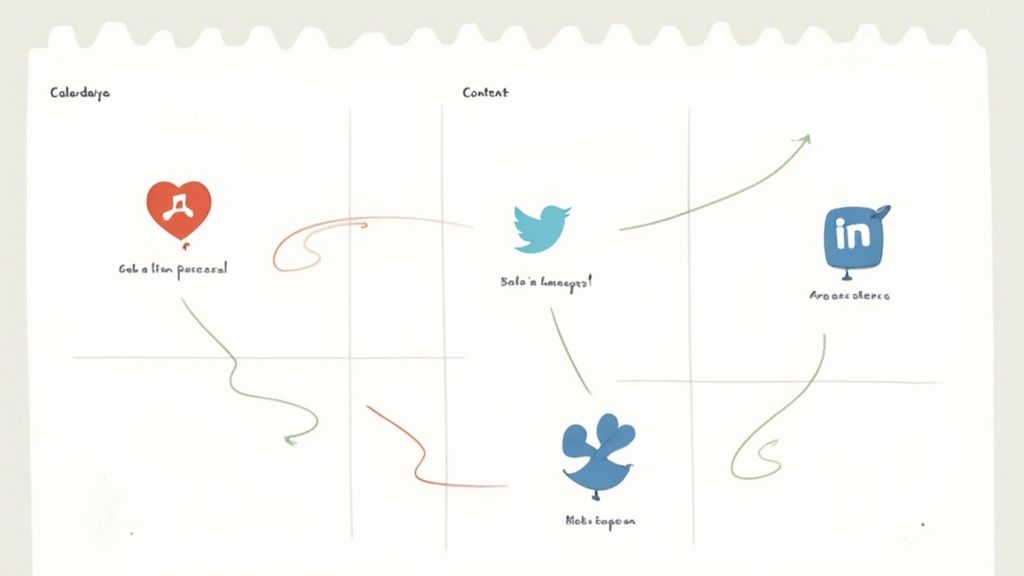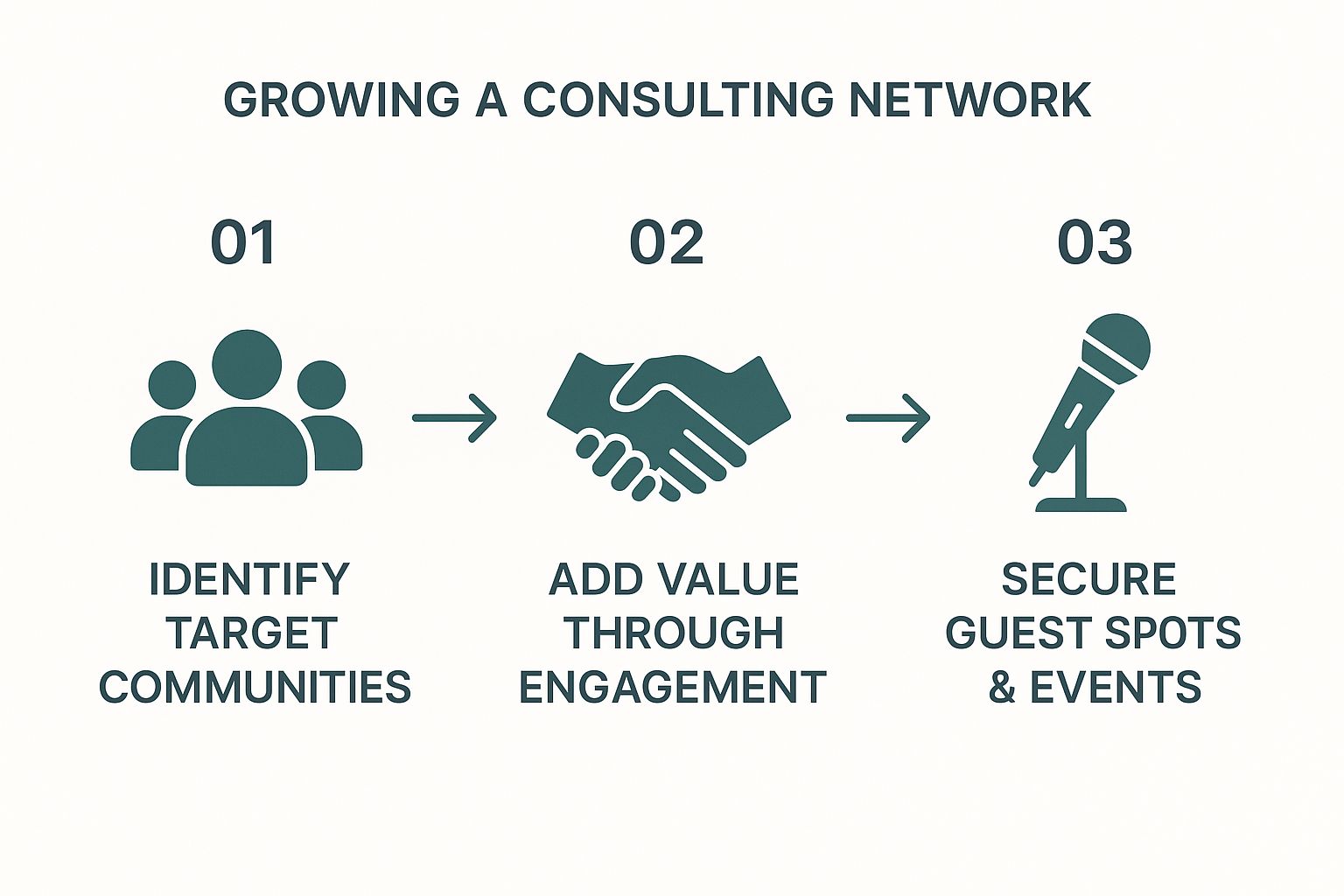Personal Branding for Consultants: Grow Your Influence
Discover effective strategies for personal branding for consultants. Build your client base ethically and stand out in your niche today!

Personal branding isn't just a marketing buzzword for consultants; it's the ethical process of defining what makes you you in a crowded marketplace. It’s about shaping how potential clients see you, making sure they understand your specific expertise, your values, and the unique results you deliver.
When done right, your personal brand ethically attracts your ideal clients before you even send the first email.
Find Your Niche and Define Your Message

Before you can build a powerful brand, you need a rock-solid foundation. This is where you get brutally honest about what makes you different.
So many consultants fall into the trap of trying to be everything to everyone. The result? A diluted message and a brand that’s completely forgettable.
The goal here is to move past generic labels and pinpoint your unique expertise, your ideal client, and the specific problems you solve better than anyone else. This isn't about some flashy slogan. It's about building a core value proposition that's an authentic, ethical reflection of why you do what you do.
Pinpoint Your Unique Value
First, you have to look inward. What specific skills, experiences, and perspectives do you bring to the table that are yours alone? This unique blend is the heart of your brand.
Answering these questions will bring a ton of clarity:
- What problems do I genuinely love solving? Think about the work that gets you fired up and in a state of flow.
- Who is my ideal client? Get specific. What industry are they in? What’s the company size? What keeps them up at night?
- What is the tangible outcome I deliver? Clients don't hire you for your time; they hire you for results. Define exactly what that result looks like.
This self-assessment is mission-critical for building a brand that feels true to you while pulling in the right kind of opportunities. You'll find plenty of tools online to help, and if you need a quick way to craft compelling openings for your content, our free hook generator can be a great starting point: https://contentide.com/hook-generator
To help you get started, use the matrix below to map out the core pillars of your personal brand. Take some time with this—it's the foundation for everything that follows.
Your Core Brand Pillars Matrix
Use this matrix to identify and articulate the foundational elements of your personal brand.
| Brand Pillar | Guiding Questions | Your Answer/Statement |
|---|---|---|
| Expertise | What specific problem do you solve better than anyone else? What is your unique methodology or framework? | |
| Ideal Client | Who do you serve? Describe their industry, role, challenges, and goals. | |
| Core Values | What ethical principles guide your work and interactions? What do you stand for? | |
| Unique Voice | How do you communicate? Are you analytical, inspiring, direct, or humorous? | |
| Tangible Result | What is the clear, measurable outcome your clients achieve after working with you? |
Once you’ve filled this out, you'll have a much clearer picture of your brand's DNA. These pillars will guide every piece of content you create and every conversation you have.
The Power of a Clear Message
Having a clear, compelling brand identity sets the stage for everything you do—from the content you create to the connections you make. The impact of this clarity is huge.
Consider this: studies show that 85% of hiring decisions are influenced by a strong personal brand, and 92% of consumers trust individual thought leaders far more than corporate messaging. This data proves that a powerful personal brand directly translates into client trust and new business.
Your personal brand is what people say about you when you're not in the room. It’s the intersection of your unique expertise, your core values, and the consistent way you show up for your audience.
For a deeper dive into establishing your unique identity as a consultant, check out this comprehensive guide on building a personal brand.
Ultimately, doing this foundational work ensures your brand isn’t just a facade. It's a genuine representation of your value, ethically attracting clients who need exactly what you offer.
Build Your Digital Footprint with Integrity

These days, your online presence is your first handshake. For a consultant, it absolutely has to build trust from the very first click. This means creating a professional, cohesive digital footprint across the platforms where your ideal clients are actually spending their time.
This isn’t a numbers game about being everywhere at once. It’s an ethical, strategic play. You’re building outposts that consistently communicate your value. A key part of this is knowing how to build an effective online presence that drives growth without sacrificing your integrity.
The goal is simple: no matter where a potential client finds you—be it your website or your LinkedIn profile—they get the exact same clear picture of who you are and what problems you solve. Consistency is the bedrock of a trustworthy personal brand.
Turn Your LinkedIn From a Resume Into a Resource
Too many consultants treat their LinkedIn profile like a dusty, digital resume. That's a massive missed opportunity. Your profile should be a dynamic resource hub that ethically pulls in and nurtures your ideal clients.
Stop just listing past jobs. Reframe your experience section to spotlight key achievements and, wherever possible, quantifiable results. Use your "About" section to tell a compelling story that directly connects your expertise to the specific pain points of your target audience.
Here’s how to make your profile a client magnet:
- Rethink Your Headline: Ditch the generic "Consultant at [Company]." State who you help and how you do it. Something like, "Helping SaaS Startups Scale Customer Retention | B2B Growth Consultant" is infinitely more powerful.
- Leverage the Featured Section: Pin your best case studies, client testimonials, or links to valuable articles you've written. This is your chance to showcase your expertise right at the top.
- Get Specific Recommendations: Don't just ask for praise. Actively request recommendations from past clients that speak to the specific results you delivered. A glowing, detailed endorsement builds serious credibility.
Your Website Is Your Central Brand Hub
While LinkedIn is non-negotiable for networking, your personal website is the only digital asset you truly own. Think of it as your central hub for your deepest insights, most detailed case studies, and clearest calls to action. A website gives you total control over your brand narrative.
Your website is where potential clients go when they’re ready to move from "interested" to "invested." It’s your opportunity to prove your value without the noise of a social media feed.
And you don't have to break the bank to build one. Platforms like Squarespace, Wix, or even a simple WordPress site offer affordable ways to create a professional online home. Just focus on a clean design, crystal-clear messaging, and an obvious way for potential clients to get in touch.
Your integrity shines through when your digital footprint is transparent, consistent, and genuinely helpful.
Create a Content Strategy That Lasts

This is where your personal brand comes to life. Content is how you prove your expertise, earn trust from a distance, and show potential clients you live in their world. But let's be clear: a frantic, "I have to post every single day" approach is a one-way ticket to burnout.
The real key to a powerful content game is a sustainable strategy that favors quality over sheer volume. It’s about creating genuinely helpful assets that cement you as the go-to expert in your niche, not just another voice shouting into the void. This is how you build real relationships, the ethical bedrock of any successful consulting business.
Don't just take my word for it. Personal branding is becoming a massive factor in B2B buying. New research suggests that soon, nearly 70% of B2B purchase decisions will lean heavily on a consultant's individual thought leadership—not just their company’s logo. Your authority, built through consistent, valuable content, is what attracts opportunities. You can check out the full findings on how personal brands are shaping B2B decisions on ohhmybrand.com.
Identify Your Core Content Pillars
Stop brainstorming random topics. Instead, build your entire content strategy on a foundation of content pillars. These are the 3-5 core themes that map directly to the biggest, most painful challenges your ideal clients face. Think of them as the main categories on your personal "show."
For instance, a management consultant who helps businesses improve operational efficiency might have pillars like:
- Process Optimization Frameworks
- Team Productivity Hacks
- Change Management Leadership
- Scaling Operations Sustainably
When you define these pillars, every piece of content you create has a home and a purpose. You’ll stay laser-focused on what your audience actually cares about, reinforcing your specific expertise with every article, post, or video you share.
Choose Your Formats Wisely
You don't need to be everywhere. A smart content strategy means picking formats that play to your strengths and match how your audience likes to consume information.
Don’t force yourself to create slick videos if you’re a brilliant writer. Choose ethics: pick a primary format where you can shine, then find affordable ways to repurpose that content for other channels.
A single, deep-dive blog post can be a goldmine. You can splinter it into five insightful LinkedIn posts, a concise email newsletter, and a visual carousel for Instagram. This is the "create once, distribute many" model. It maximizes your impact without multiplying your workload, allowing you to maintain a steady presence without the constant pressure of starting from scratch. For more ideas, check out the Contentide blog.
Create an Affordable and Realistic Calendar
Consistency always wins against intensity. A simple content calendar—even a basic spreadsheet—is all you need to stay on track. Plan one "hero" piece of content every week or two, then schedule the smaller, repurposed pieces around it.
This approach keeps you showing up and adding value without getting overwhelmed. A consultant's brand is built on trust, and trust comes from a reliable presence that proves you’re in it for the long haul.
Grow Your Network and Amplify Your Voice
A strong personal brand doesn't exist in a vacuum. It lives and breathes within a community of your peers, clients, and collaborators. Your expertise only gains real traction when it’s shared, discussed, and passed around by other people.
This is where ethical, strategic networking comes in—both online and off. It’s how you turn a personal brand into actual business opportunities.
This isn’t about collecting thousands of empty connections on LinkedIn. It’s about building real relationships by actually contributing to conversations, sharing useful insights on other people's posts, and consistently adding value. The core idea is simple and timeless: give generously before you ever ask for anything in return.
Move Beyond Passive Connections
Too many consultants treat platforms like LinkedIn as a digital Rolodex. It’s just a place to store contacts. To build a brand that actually works for you, you have to shift your mindset from collecting names to creating connections. That means showing up and engaging where your ideal clients already are.
I see this as a three-phase process: first, you figure out where your audience hangs out. Then, you add value through consistent, helpful engagement. Finally, you start looking for bigger stages to share your expertise.

As the infographic lays out, the flow is logical. You move from listening, to participating, and finally to speaking with authority. This approach makes sure you build a reputation for being genuinely helpful long before you ever try to sell anything.
The power of this kind of authentic engagement is hard to overstate. When you consistently share valuable insights, your network becomes your best marketing channel. In fact, messages shared by consultants are reshared on social media 24 times more often than messages from a corporate account.
Even better, leads generated through these personal social channels convert at rates seven times higher than other lead sources. This proves that your individual presence directly drives the bottom line. You can find more stats on personal branding's impact from research by dsmn8.com.
Affordable Strategies for Brand Amplification
You don’t need a massive marketing budget to grow your influence. By focusing on a few high-impact, low-cost activities, you can cement your expert status and reach a much wider audience.
Here are a few practical, affordable strategies that work:
- Engage in Niche Industry Communities: Find the right groups on LinkedIn, Slack, or other platforms where your ideal clients are asking questions. Become a go-to resource by providing thoughtful answers without a sales pitch attached.
- Participate in Virtual Events: Don't just attend webinars and online summits—participate. Asking smart questions and contributing to the chat can get you noticed by hundreds of potential connections in a single hour.
- Seek Guest Podcast Spots: Podcasts are constantly looking for experts to interview. Find the shows your ideal clients listen to and pitch them a specific, valuable topic you can own. It's a powerful way to borrow an established audience's trust at no cost.
Meaningful networking isn't about what you can get; it's about what you can give. Every helpful comment, shared resource, or insightful answer is a deposit into your brand's trust fund.
Of course, managing this level of consistent engagement can feel like a full-time job. For a deeper look at platforms that can help streamline your LinkedIn activity, you might be interested in our comparison of Taplio and similar tools. The key is to find a sustainable, affordable rhythm that keeps you visible and valuable without burning you out.
Track Your Brand's Impact and Plan for Growth
Building a powerful personal brand is a long game, not an overnight sprint. But if you’re not measuring what’s working, you’re essentially flying blind. Tracking your brand’s impact gives you a feedback loop, letting you see what resonates so you can adapt, refine, and grow your influence with intention.
https://www.youtube.com/embed/kV9Deg1SJ1s
This isn't about chasing vanity metrics like follower counts. It’s about focusing on the key performance indicators (KPIs) that connect your brand-building efforts to actual business outcomes—like getting more of the right clients to knock on your door.
Identifying KPIs That Actually Matter
The metrics that matter for a solo consultant are worlds away from what a large corporation tracks. You need to zero in on signals that indicate growing authority and genuine client interest. The good news is, you can do this without shelling out for expensive software.
Start by keeping an eye on these high-impact KPIs:
- Inbound Inquiries: How many potential clients are reaching out through your website or LinkedIn? Take note if they mention a specific article or post they saw—that’s gold.
- LinkedIn Profile Views: Pay close attention to who is looking at your profile. Are they from your target industries? A steady climb in views from the right people is a fantastic sign.
- Content Engagement Rate: Look past the likes. Are people leaving thoughtful comments, asking questions, or sharing your posts? Real engagement is a sign your content is hitting the mark.
- Website Traffic Referrals: Check your website analytics. Where are visitors coming from? If you see a spike from LinkedIn right after you publish a new article, you know that channel is paying off.
A consultant's brand health isn't measured in raw numbers but in the quality of the engagement. One inbound lead from a CEO who read your case study is worth more than a thousand passive followers.
Creating a Simple Tracking Scorecard
You don’t need a complicated analytics dashboard. A simple spreadsheet is one of the most effective and affordable tools for tracking your progress on your personal branding for consultants journey. Building a scorecard helps you monitor what’s happening and, just as importantly, holds you accountable.
This gives you a clear, at-a-glance view of what's moving the needle and where you might need to adjust your strategy. Regular check-ins are key to staying focused on sustainable, meaningful growth.
Below is a simple scorecard to get you started. This tool helps you track key metrics related to your personal brand's growth and engagement.
Your Brand Impact Tracking Scorecard
| Metric Category | Key Performance Indicator (KPI) | Tracking Frequency | Goal |
|---|---|---|---|
| Visibility | LinkedIn Profile Views | Weekly | Increase views from target companies by 15% this quarter. |
| Engagement | Average Comments per Post | Monthly | Achieve an average of 5 meaningful comments per post. |
| Lead Generation | Inbound Website Inquiries | Monthly | Generate at least 2 qualified inquiries per month. |
| Authority | Mentions/Shares by Industry Peers | Quarterly | Be mentioned or have content shared by 3 peers this quarter. |
Treat this scorecard as a living document. Your goals will change as your brand evolves, but the habit of tracking your impact is what will ultimately drive your success.
A Few Common Questions About Personal Branding
Even the most experienced consultants run into the same roadblocks when building a personal brand. It’s a process that naturally brings up questions about strategy, time, and even self-doubt. Let's tackle some of the most frequent ones I hear.
How Much Time Does This Actually Take?
This is the big one. The time commitment isn't as scary as you might think, but the key is consistency over intensity. Forget spending hours a day. The real wins come from small, sustainable actions that compound.
Aim for 2-4 hours per week, focused on high-leverage, affordable activities.
- Daily LinkedIn Engagement: Set aside 15-20 minutes a day to drop thoughtful comments on posts from potential clients and other leaders in your space. This is non-negotiable.
- Weekly "Hero" Content: Block out an hour or two each week to write one solid piece of content—a detailed article, a case study, or a deep-dive post.
- Repurposing: Use another hour to slice that hero piece into smaller posts for the rest of the week.
This approach is manageable and builds a genuine presence without leading to burnout.
Your personal brand is a marathon, not a sprint. The goal is to build a rhythm you can maintain for years, not a pace that burns you out in weeks. Sustainable effort is the key to long-term success.
Do I Really Need a Personal Website?
Yes. No question.
While platforms like LinkedIn are incredible for visibility and connecting with people, your website is the only piece of digital real estate you truly own. It’s your home base, where you control the narrative and showcase your best work—case studies, testimonials, and deep insights—without an algorithm getting in the way.
Think of it like this: LinkedIn is a rented booth at a busy trade show. Your website is your flagship store. You need both to succeed, but only one gives you total control over the experience.
What If I Don't Feel Like an "Expert"?
Welcome to the club. Imposter syndrome is real, and it can feel completely inauthentic to put yourself out there as an authority. The secret is to reframe what "expert" means.
You don't need to know everything. You just need to know more than your ideal client about the specific problem you solve for them. That's it.
Your expertise is relative. Focus on sharing what you do know. Document your process. Talk about lessons learned from projects. Discuss the challenges you've helped clients overcome.
Ethical branding is your greatest asset. A personal brand isn't about projecting perfection. It's about being a trusted, transparent guide who consistently shows up to help. That builds far more trust than a facade of flawless expertise ever could.
Building that consistent, authentic presence on LinkedIn is one of the most powerful things you can do for your personal brand. I built Contentide to help consultants do exactly that—turning your raw ideas into engaging posts in minutes, so you can get back to what you do best. We believe in providing an affordable product that delivers real value.
Check out how Contentide can streamline your content creation.
Hope you found this helpful. Feel free to share your thoughts.